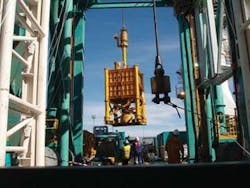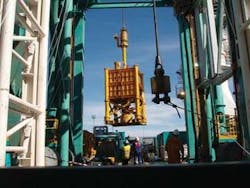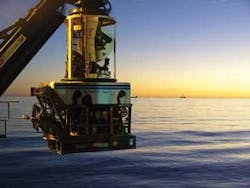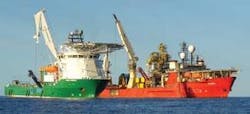Rigless well intervention proves value on Vincent subsea installations
Tom Leeson - TSMarine (Contracting)
In 2007, Woodside Energy contracted TSMarine to perform the first fully integrated rigless subsea well intervention project in the Asia-Pacific region, on the Vincent field development off Western Australia.
Phase 1 of the project, completed earlier this year, was operated from the intervention vesselHavila Harmony in a water depth of 372 m (1,220 ft) and reaching downhole depths of more than 1,450 m (4,757 ft). This was the first deployment and installation on wire of subsea christmas trees from a monohull vessel in the Asia-Pacific, and also the first subsea well intervention using wireline services from a monohull in Australian waters.
To date, seven subsea tree installations have been completed successfully, followed by wireline intervention to commission wells for operation to/from the host facility, an FPSO. TSMarine also has severed and recovered numerous P&A’d wellheads from earlier wells drilled on the field.
Offshore operators globally are increasingly recognizing the benefits of conducting well operations without a traditional rig, and are turning to rigless well intervention as a more cost-effective and efficient alternative. By installing subsea christmas trees on wire and deploying a subsea lubricator from a DP intervention vessel, TSMarine takes time-consuming well operations away from expensive rigs, allowing these units to be deployed more effectively for drilling and well construction.
This approach, however, presents technical and commercial challenges – the scope of work assigned to the vessel must match its capabilities and those of the onboard equipment. At the same time, costs to prepare the vessel, the personnel, and the work program must be understood and also demonstrated to deliver savings over traditional methods. This situation can be compounded when operating in remote areas where the cost of mobilizing the vessel to the worksite can impact significantly the overall project cost.
For the Vincent rigless intervention campaign, savings were achieved by decoupling the rig schedule from the construction schedule, thereby accelerating the overall drilling program and removing the need to reconfigure or modify the rig each time a tree was deployed. Furthermore, the multi-role intervention vessel could be employed on other tasks such as field commissioning and installation support and subsea maintenance.
Safety preparations
Vincent is in production license WA-28-L, around 50 km (31 mi) northwest of Exmouth on Western Australia’s North West Cape. This is a fairly conventional subsea development with 11 subsea wells tied back to the FPSOMaersk Ngujima-Yin Yin. Initial preparations for the planned intervention program started in late 2006.
First-phase well intervention operations involved deployment and installation from the dynamically positionedHavila Harmony,of seven subsea trees in the field on wire, and using a subsea wireline lubricator to pull the suspension plugs from the completion to allow the well to flow to the host facility at a later date.
Havila Harmony, built to the new Clean Comfort V Norwegian standards, is configured to undertake subsea decommissioning, rigless well intervention, and subsea construction support activities.
The vessel has been on long-term charter to TSMarine since early 2007, and has been upgraded to meet DNV Well Notation Class through installation of an automated fire and gas system, extra life boats, and a blast wall to protect the accommodation area. In addition, a Safety Case was submitted to the Australian National Offshore Petroleum Safety Authority (NOPSA) to verify the design, construction, and operation of all safety-critical components of the systems employed in the operation.
Subsea trees have been installed previously on wire, mainly in the Gulf of Mexico, West Africa, and Brazil, but this was the first such project in Australia. It was imperative that health and safety was not compromised, so a hazard identification and risk assessment (HIRA) was performed for each stage of the operation. This identified potential risks in areas such as manual handling, over-boarding heavy lifts, and familiarizing personnel with aspects of the project that required particular attention.
In order to interface the lubricator to the subsea tree, a cross-over spool was designed and fabricated, while specifications were prepared for the well services contractor’s wireline, pumping, and fluid handling requirements. And with this being the first operation of its kind for the operator and contractor, various support systems had to be developed, including philosophies relating to well control, barriers and emergency shutdown and disconnection, project management processes, and training programs for project personnel.
Two methods of deploying the trees were considered. Having evaluated the dynamic load factors and environmental conditions, the team opted to install the trees using the vessel’s 150-metric ton (165-ton) crane rather than through the moon pool on guide wires, which had been the original plan. With each tree weighing around 36.5 metric tons (40.23 tons), and weather warnings of up to 2.5 m (8.2 ft) significant wave height and 30 knot winds, causing the vessel to pitch at 5°, the Hydromarine active heave-compensated crane provided both operational advantages and reduced HSE risk.
Operating in a water depth of 372 m (1,220 ft) presented no major challenges for the vessel, which is equipped with two deepwater work class ROVs, theTriton XLS 19 and Triton XLS 20, both capable of operating in depths of 3,000m (9,842 ft). These were used to monitor and assist with the installation operation.
A purpose-built, ROV-mounted hydraulic work-pack was applied to lock and test both wellhead and flowline connections. To enable this, the subsea tree was fitted with a recoverable MQC interface assembly at the surface prior to deployment. This obviated the need for a workover control system to be mobilized and for the attendant umbilical to be managed.
The ROVs were used throughout the operation, providing a great deal of flexibility so that preparations could be made on the next wellhead while the subsea tree just installed was being latched and tested. Following this batch of installations, the subsea lubricator equipment was mobilized to undertake the wireline operations.
First-phase results
In total, seven subsea trees were installed successfully and prepared for the first phase of operations using wireline intervention. The water depth of 372 m was only 5 m (16.4 ft) shallower than the deepest rigless wireline intervention ever performed – a notable achievement given the relative inexperience of the participants. And there were no reported incidents during the operation, emphasizing the value of the continual attention to safety that was maintained prior to and throughout the operational phase.
Taking this approach as opposed to “normal” tree running meant an additional 28 days drilling activity was completed in the available window. This gain translates directly into accelerated production.
The project has demonstrated the viability of using rigless techniques to install subsea trees and to intervene on subsea wells, and the program can be considered a significant milestone for subsea operations in the region. Operations are ongoing to complete the expansion of the Vincent project, and numerous production enhancement opportunities are being planned for the near future including PLT surveys, water shut-offs, and gas-lift valve installation.
The flexibility of this approach could be applied also to well maintenance tasks such as subsea safety valve and gas lift valve change-out, production logging, plug setting, perforating, water shut-off, and tractor operations such as scale milling, and in highly deviated sections together with pumping operations, including scale treatments.
This ground-breaking project can be built-on in the future and the range of operations undertaken from a monohull vessel could be extended to minimize costs incurred in well operations.



